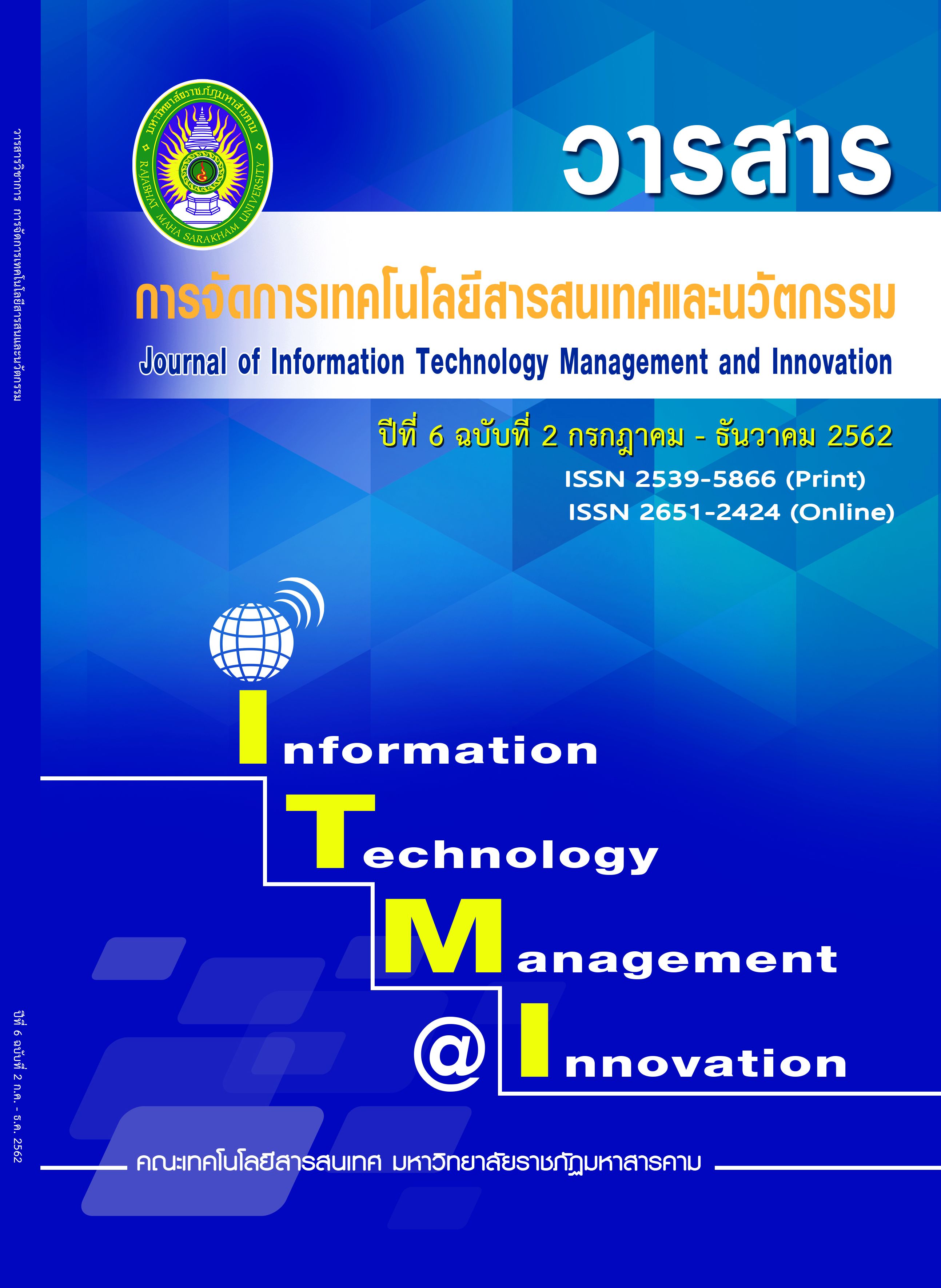การตรวจจับการบุกรุกด้วยเทคนิคการจำแนกในการทำเหมืองข้อมูล
Main Article Content
บทคัดย่อ
งานวิจัยนี้มีวัตถุประสงค์เพื่อ 1) พัฒนาแบบจำลองที่สามารถจำแนกและตรวจจับการบุกรุกในระบบเครือข่าย และ 2) เปรียบเทียบประสิทธิภาพการจำแนกรูปแบบการบุกรุกในระบบเครือข่าย เครื่องมือที่ใช้ใน การจำแนกข้อมูลรูปแบบการบุกรุกบนระบบเครือข่าย คือ โปรแกรม WEKA โดยใช้เทคนิคการจำแนกในการทำเหมืองข้อมูล 4 เทคนิคด้วยกันคือ เทคนิค Decision Table, เทคนิค Naïve Bayes, เทคนิค RIPPER และเทคนิค PART decision list เพื่อพัฒนาแบบจำลองและเปรียบเทียบประสิทธิภาพการจำแนกรูปแบบการบุกรุกในระบบเครือข่าย ในงานวิจัยนี้ใช้ชุดข้อมูลการบุกรุกระบบเครือข่ายจากฐานข้อมูลความรู้ KDD Cup’99 หลักการ 10-Fold Cross Validation ได้ถูกนำมาใช้ในการแบ่งชุดข้อมูลออกเป็นชุดเรียนรู้และชุดทดสอบ สถิติที่ใช้ในการวิจัย 1) ค่าความแม่นยำ Precision 2) ค่าระลึก Recall และ 3) ค่า F-Measure
ผลการทดลองพบว่า 1) แบบจำลองที่ใช้เทคนิค RIPPER มีค่า Precision มากที่สุดคือ 99.00% และเทคนิค PART decision list มีค่า Precision 98.20% ตามด้วยเทคนิค Decision Table มีค่า Precision 97.50% และเทคนิคที่มีค่าความถูกต้องน้อยที่สุดคือ เทคนิค Naïve Bayes มีค่า Precision 49.40% และ 2) ผลเปรียบเทียบการวิเคราะห์แบบจำลองการจำแนกการตรวจจับการบุกรุกของแต่ละเทคนิค พบว่า แบบจำลองที่ใช้เทคนิค RIPPER ให้ค่าเฉลี่ยทางสถิติเป็นเปอร์เซ็นต์มากที่สุดอย่างมีนัยสำคัญ จากเทคนิคทั้งหมด 4 เทคนิค
Article Details
เอกสารอ้างอิง
[2] เอกสิทธิ์ พัชรวงศ์ศักดา. (2556). คู่มือการใช้งาน Weka Explorer เบื้องต้น. กรุงเทพฯ: เอเชียดิจิตอลการพิมพ์.
[3] ธนกร มีหินกอง และประสงค์ ปราณีตพลกรัง. (2555). ระบบตรวจหาการบุกรุก. กรุงเทพฯ: สถาบันวิทยาการสารสนเทศ มหาวิทยาลัยศรีปทุม.
[4] ธนาวุฒิ เอื้อชัยกุล. (2551). การสร้างชุดคำสั่งบีเพลสำหรับกฎธุรกิจจากตารางการตัดสินใจ. (วิทยานิพนธ์ปริญญามหาบัณฑิต)
จุฬาลงกรณ์มหาวิทยาลัย: กรุงเทพฯ.
[5] เอกสิทธิ์ พัชรวงศ์ศักดา. (2557). An Introduction to Data Mining Techniques. กรุงเทพฯ: เอเชียดิจิตอลการพิมพ์.
[6] Anil Rajput. (2011). J48 and JRIP Rules for E-Governance Data. International Journal of Computer Science and Security, (5).
[7] Frank Eibe & Witten H. Ian. (1998). Generating Accurate Rule Sets Without Global Optimization.
(the Fifteenth International Conference on Machine Learning).
[8] KDD Cup. (1999). Data. Retrieved from http://kdd.ics.uci.edu/databases/kddcup99/kddcup99.html
[9] อรนุช พันโท และมนต์ชัย เทียนทอง. (2557). การเปรียบเทียบประสิทธิภาพการจำแนกรูปแบบการเรียนรู้ VARK ด้วยเทคนิค
เหมืองข้อมูล. วารสารเทคโนโลยีอุตสาหกรรม มหาวิทยาลัยราชภัฏอุบลราชธานี, 4(1), pp. 1-11.
[10] ปรีชา สมหวัง และศิริวัฒน์ โทศิริกุล. (2553). ระบบตรวจจับการใช้งานคอมพิวเตอร์ในทางที่ผิด. National Conference on
Information Technology, NCIT2010. pp. 409-414.
[11] ปวีณา ชัยวนารมย์. (2558). การพัฒนาแบบจำลองเพื่อพยากรณ์การเกิดความเครียดในหลายระดับด้วยเทคนิคการทำเหมือง
ข้อมูล. (รายงานการวิจัย). กรุงเทพฯ: มหาวิทยาลัยเทคโนโลยีราชมงคลรัตนโกสินทร์.
[12] ณัฐวุฒิ ปั้นรูป และอัฐพร กิ่งบู. (2558). Data Classification by K-Means and Multi-Class SVM for Intrusion Detection
System. National Conference on Information Technology, 7.
[13] ธนกร มีหินกอง. (2558). สถาปัตยกรรมความรู้ด้านความมั่นคงปลอดภัยไซเบอร์เพื่อสนับสนุนระบบตรวจหาการบุกรุกแบบ
ปรับตัวด้วยเทคนิคกฎความสัมพันธ์. วารสารวิชาการพระจอมเกล้าพระนครเหนือ, 25(2), 277-288.
[14] ไพชยนต์ คงไชย. (2557). การพัฒนาขั้นตอนวิธีเพื่อจำแนกประเภทข้อมูลด้วยกฎความสัมพันธ์แบบคลุมเครือที่กะทัดรัด.
(วิทยานิพนธ์ปริญญาดุษฎีบัณฑิต) มหาวิทยาลัยเทคโนโลยีสุรนารี, นครราชสีมา.


